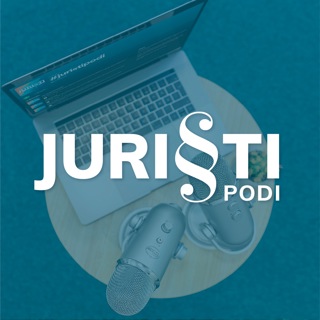
Blogcast: Stopping One of Your Biggest Revenue Leaks: Discounts
This is an Impact Pricing Blog published on February 15, 2024, turned into an audio podcast so you can listen on the go. Read Full Article Here: https://impactpricing.com/blog/stopping-one-of-your-biggest-revenue-leaks-discounts/ If you have any feedback, definitely send it. You can reach us at mark@impactpricing.com. Now, go make an impact. Connect with Mark Stiving: Email: mark@impactpricing.com LinkedIn: https://www.linkedin.com/in/stiving/
5 Huhti 20242min
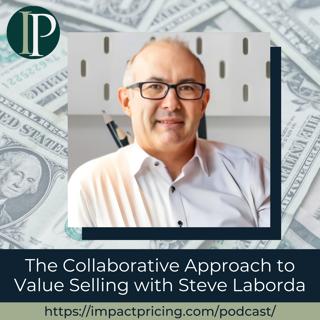
The Collaborative Approach to Value Selling with Steve Laborda
Steve Laborda is a CEO of Valuebizbooster, Consultant, Coach, Author and Speaker. He is a practitioner in B2B sales and marketing, focusing on improving profitability, how to capture value, and developing the competencies of the commercial people through customer orientation and commercial excellence. In this episode, Steve delves into the intricate blend of art and science involved in the sales process. He emphasizes the importance of incorporating intangibles alongside hard facts, highlighting that both are essential for success and reaching a deal. Furthermore, he underscores the collaborative efforts of individuals within the company, working cohesively as a team to uphold a value-based approach throughout the entire sales process. Why you have to check out today's podcast: Find out the three essential components to value selling in which without each one no decision is reached Discover how value-based selling works in the whole sales process within the company Uncover the effective use of the ROI calculator as a value driver "Don't forget to work with sales when you do your pricing." - Steve Laborda Topics Covered: 01:00 - How he got into pricing 01:30 - The many roles he played 02:41 - Pointing out the 'art' in value, pricing, and selling 04:16 - The intangible benefit other than the emotional, and cognitive aspect of value selling 06:24 - How was his experience different from any other salesperson who's good at building relationships 9:47 - Examples illustrating the three components of the sales process of relationship building, the science part, and the intangibles 11:38 Defining cross-functional value selling 15:04 - Why companies often fail at value-based pricing 17:55 - Calling it a value calculator and not the ROI calculator 20:10 - Why a collaborative way of using the value calculator instead of leaving it to the customer alone 23:36 - Reasons customers likely buy from you 25:35 - Pricing a highly volatile product in the chemical industry 29:23 - Steve's best pricing advice Key Takeaways: "Yes, you need to do value quantifications, but you need to be able also to be emotional and to read body language and to read the skills that people have in front of you." - Steve Laborda "You need to have sales, marketing, pricing, the technical people, if it's a technical context, to have all those people together to develop that value-based approach so that everybody is behind it..." - Steve Laborda "The value calculator is there for me to give confidence to the salesperson about the price that you can defend to the customer." - Steve Laborda Connect with Steve Laborda: LinkedIn:https://www.linkedin.com/in/stevelaborda/ Connect with Mark Stiving: LinkedIn: https://www.linkedin.com/in/stiving/ Email: mark@impactpricing.com
1 Huhti 202430min

Blogcast: Proven Value
This is an Impact Pricing Blog published on February 8, 2024, turned into an audio podcast so you can listen on the go. Read Full Article Here: https://impactpricing.com/blog/proven-value-can-be-a-game-changer/ If you have any feedback, definitely send it. You can reach us at mark@impactpricing.com. Now, go make an impact. Connect with Mark Stiving: Email: mark@impactpricing.com LinkedIn: https://www.linkedin.com/in/stiving/
29 Maalis 20242min
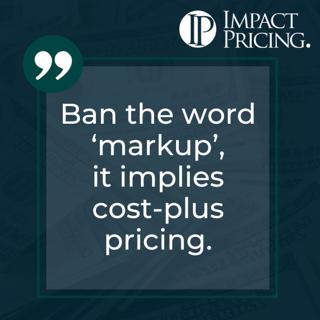
Pricing Table Topics: 8 of Clubs – Ban the Word 'Markup'
This one is the 8 of Clubs from the Impact Pricing card deck. Ban the word markup. First, can we all agree that cost-plus pricing is not optimal? We really want to do value-based pricing, charge what a customer is willing to pay. Got it, so we're all in agreement. Now, let's talk about the word markup. Markup is defined as, tell me what my costs are, how much do I need to mark that up in order to get the margins that I want? So a markup is by definition cost-plus. Well, it's cost-times, but it's cost-plus. So when we use the word markup, as a company, we're saying we use cost-plus pricing. Now, it is okay, let's say you're running a distribution organization. You're running a grocery store. You've got hundreds of thousands of products to price. You can't do specific value-based pricing on each one of those products. And so, you have to do something. But don't do just cost-plus. When you say we use a 50 point markup or a 20 point markup, we're implying that goes across the board. What we should be saying is, how much margin do we think we can get from this product category? Because margin starts at, what's the price? And then, how much did we have to pay to acquire the product that we sold? So margin is a great term to use when we're thinking about value-based pricing. Markup almost forces us to use cost-plus pricing. So my advice, stop using that word. Don't let anybody else use that word. Switch your mental thought process to margin, not markup. We hope you enjoyed this example of Pricing Table Topics. What you just heard was done without a script. If you have any questions or feedback, please email me, mark@impactpricing.com. Now, go make an impact. Connect with Mark Stiving: Email: mark@impactpricing.com LinkedIn: https://www.linkedin.com/in/stiving/
27 Maalis 20242min
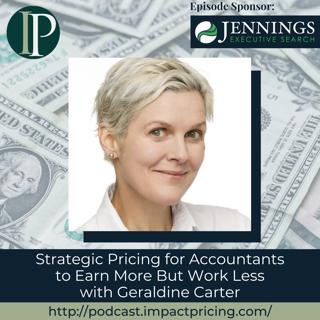
Strategic Pricing for Accountants to Earn More But Work Less with Geraldine Carter
Geraldine Carter helps single-owner CPAs go down to 40 hours without giving up revenue. In this episode, Geraldine reveals effective strategies for tailoring your accounting service business to suit your lifestyle, enabling you to increase revenue without feeling overwhelmed by excessive work. Why you have to check out today's podcast: Discover how accountants can increase their earnings while reducing their workload Learn to craft your message to highlight the value you offer, rather than focusing solely on the cost of your services Uncover the transformation within the services you offer "Your clients have an expectation to pay and if your prices are too low, they might not buy from you." - Geraldine Carter Topics Covered: 01:56 - Working less but earning more 03:41 - Flexibility, autonomy and working less hours 05:38 - Mindset shift to less hours work 08:48 - Pricing strategies so accountants work less and increase income 11:10 - How message is structured to a CPA's client in terms of raising his price 14:44 - The idea of selling services but delivering transformations 16:42 - Understanding the services accountants perform and how they earn recurring income 17:20 - What transformation does accountants deliver to companies 22:36 - The beauty of having people see the value in your own business Key Takeaways: "The revenue that you create in your business has nothing to do with the time that you put in. I mean, you have to grind out the beginning to get it all set up and going. But you can get to the place where you do not have to work 40 or 25 or 15 hours a week. You just have to stay at it until you figure out how to get your hours down." - Geraldine Carter "Thinking that revenue comes from work for clients is like thinking that time comes from your watch, it's not how that works." - Geraldine Carter "Your buyer decides what price they want to pay. So, we do tiered pricing, we offer it to the clients." - Geraldine Carter "Most accountants are selling services, but they're creating and delivering transformations." - Geraldine Carter "For business owners listening, do not underestimate the power of pricing wisely." - Geraldine Carter Connect with Geraldine Carter: Website: https://geraldinecarter.com/ LinkedIn: https://www.linkedin.com/in/geraldine-carter/ Connect with Mark Stiving: LinkedIn: https://www.linkedin.com/in/stiving/ Email: mark@impactpricing.com
25 Maalis 202426min
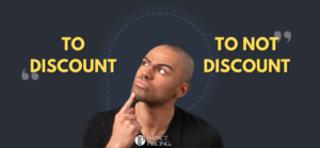
Blogcast: To Discount or Not to Discount
This is an Impact Pricing Blog published on February 1, 2024, turned into an audio podcast so you can listen on the go. Read Full Article Here: https://impactpricing.com/blog/to-discount-or-not-to-discount/ If you have any feedback, definitely send it. You can reach us at mark@impactpricing.com. Now, go make an impact. Connect with Mark Stiving: Email: mark@impactpricing.com LinkedIn: https://www.linkedin.com/in/stiving/
22 Maalis 20242min
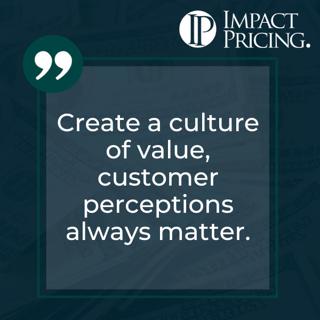
Pricing Table Topics: 8 of Diamonds – Customer Perceptions Always Matter
This one is the 8 of Diamonds from the Impact Pricing card deck. Customer perceptions always matter. And what's fascinating is every time we touch a customer, we touch a buyer, they form perceptions of our company. They could be positive perceptions. They could be negative perceptions. And when I say every time, it's not only salespeople making sales calls. It's when they read our marketing messages. It's when they receive our invoices. It's when they call our customer support or customer service line. Every single touch point we have with a customer either creates value in their mind, or it destroys value in their mind. The question becomes, which are we going to do? My recommendation is obviously to create more value with every customer touch point. But how do we do that? We do that by creating a culture of value Inside our company. A customer centric perspective that says, how is it that this decision, how is it that this action, impacts our customers? And can I do it in a way that impacts our customers in a more positive manner instead of just thinking about how do I get them off the phone? Or how do I take care of them quickly so that they go away and stop bothering me while I do my day job? So value, a culture of value, is all about doing what's best for our customers and making sure every customer touchpoint increases value, not decreases it. We hope you enjoyed this example of Pricing Table Topics. What you just heard was done without a script. If you have any questions or feedback, please email me, mark@impactpricing.com. Now, go make an impact. Connect with Mark Stiving: Email: mark@impactpricing.com LinkedIn: https://www.linkedin.com/in/stiving/
20 Maalis 20242min

Balancing Curiosity, Specialization, and Success as a Pricing Professional with Robert Ribciuc
Robert Ribciuc is the Managing Partner at EBITDA Catalyst. He helped establish, grew, and managed a successful advisory/consulting firm focusing on pricing strategy and analytics, go-to-market optimization, and revenue management for middle-market corporate and private equity portfolio (PE) clients in diverse industry verticals. In this episode, Robert shares the key to succeeding as a pricing practitioner: nurturing curiosity. By continually seeking new experiences and knowledge, you'll not only advance in your current role but also pave the way for future promotions, ultimately leading to a successful career as a consultant. Why you have to check out today's podcast: Explore effective strategies for boosting personal and professional development as a pricing professional Discover the endless possibilities that come with nurturing your curiosity in the field of pricing Find out significant insights about specialization at the same time taking a broad approach in the pricing profession "Without curiosity, you wouldn't have tried and you wouldn't know how much room for improvement to have." - Robert Ribciuc Topics Covered: 01:51 - The breadth of the pricing field extending beyond one's job 03:57 - Specializing in a particular industry versus embracing a multifaceted approach to pricing 08:37 - The importance of constantly learning and adapting in pricing 12:02 - How pricing professionals can be better at what they do 14:40 - How curiosity gets your job done easily and gets you promoted 20:46 - The challenge of teaching for students in university versus teaching for companies 26:08 - Summarizing what the whole topic is about 28:18 - Robert's motivational message Key Takeaways: "Go read a book about a different industry, something that's not pricing. Also, get out of your chair and go walk to our product people, go walk to our marketing people and make some friends. Get them to tell you what their job is like and what they're thinking about." - Robert Ribciuc "Curiosity is kind of the opposite of, 'I can do it easy.'" - Robert Ribciuc "In many companies the curiosity gets subdued by, 'Oh, I find that if I just do this repeated cycle my boss is happy enough,' right? And that can be an illusion." - Robert Ribciuc People/ Resources Mentioned: Ronald Baker: https://impactpricing.com/podcast/497-classic-trash-the-timesheet-exploring-opportunities-in-subscription-businesses-with-ronald-j-baker/ Susan David: https://www.susandavid.com Vendavo: https://www.vendavo.com Pros: https://pros.com Zoom: https://zoom.us Honeywell: https://www.honeywell.com/us/en Connect with Robert Ribciuc: LinkedIn: https://www.linkedin.com/in/ribciuc/ Email: robert@ebitdacatalyst.com Connect with Mark Stiving: LinkedIn: https://www.linkedin.com/in/stiving/ Email: mark@impactpricing.com
18 Maalis 202429min




















